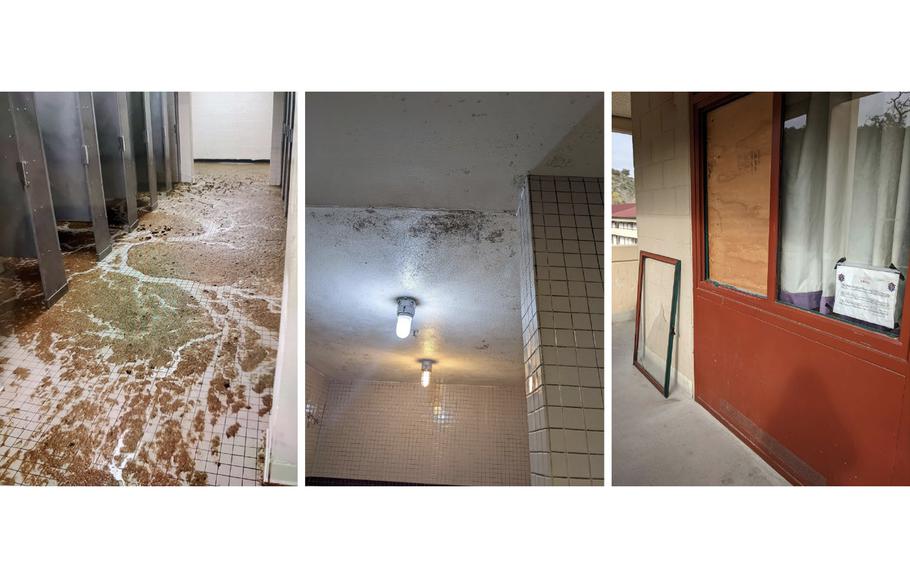
Junior-enlisted troops without dependents typically live in military-managed barracks. A Government Accountability Office report in September 2023 found some barracks pose serious health and safety risks. GAO investigators observed conditions such as sewage overflow, mold and mildew, and broken windows and locks. (Defense Department, Government Accountability Office)
Several senators are demanding the Pentagon improve the poor conditions of its barracks across the armed forces and better track costs associated with improving living quarters for troops.
The senators in a letter to Defense Secretary Lloyd Austin sent last week questioned the Pentagon’s apparent failure to properly evaluate the conditions in thousands of military barracks on bases worldwide and asked the service branches to invest more in their junior enlisted quarters in the years ahead.
The Oct. 31 letter signed by four Republicans and two Democrats cites findings in a damning September report from the Government Accountability Office that found junior enlisted troops in all the service branches living in barracks with mold, missing kitchenettes, sewage overflow, water-quality issues, rodent infestations, broken air conditioning and other unsafe conditions.
“At a time when the Department of Defense is rightly working to address serious recruitment and retention issues, reports of poor living conditions serve only to dissuade qualified Americans from considering military service,” Sens. Jon Ossoff, D-Ga., John Cornyn, R-Texas, Raphael Warnock, D-Ga., Ted Cruz, R-Texas, Marco Rubio, R-Fla., and Ted Budd, R-N.C., wrote. “Moreover, those who have already answered the call to serve deserve a standard of living commensurate with the most modern and capable fighting force in the world. Anything less represents a failure to uphold the U.S. government’s commitments and endangers military readiness.”
Despite media attention in recent years highlighting problems with mold and other issues in barracks across the military, the Pentagon does not have standardized ways to track conditions in its living quarters, nor does it properly track costs associated with barracks upkeep, according to the GAO report.
The government watchdog said none of the military services could provide “complete or reliable” information on how much the services have spent to improve barracks, how much money that they have available to improve barracks or how much they would need to meet basic living standards across all their barracks.
The GAO also charged the military has failed to study how barracks issues affect the morale of troops or their desires to stay in uniform.
Pentagon officials have acknowledged the problems that troops face in on-post housing, including in the junior enlisted barracks. The Army in 2022 condemned more than a dozen barracks buildings on Fort Bragg, N.C. — now Fort Liberty — after senior service officials toured the outdated buildings with major heating, air conditioning and ventilation flaws. The Army moved some 1,200 soldiers out of those buildings, which were either marked for renovation or demolition.
Army officials at a House hearing on barracks conditions following the GAO report said it would need to spend at least $6.5 billion in coming years to improve barracks conditions. Top Army officials said the service has some 6,700 barracks buildings across the service, and at least 300 of those are in poor or failing condition.
The Senators wrote in their letter of their continued “frustration regarding atrocious and unacceptable conditions in barracks facilities across the armed forces.” They urged Austin to ensure future budget requests, including the fiscal 2025 budget request expected in the spring, better account for needed improvements in barracks.
They demanded Austin’s next budget request include funding for “100% of assessed barracks sustainment, restoration and modernization, requirements.” They asked the Pentagon to include in the budget request specific amounts each service requires to sustain, restore and modernize its barracks. And the senators urged Austin to implement a “consistent methodology across each service” to assess the needs in military barracks.
The senators also want Austin to include in the 2025 budget request long-term, installation-specific needs to construct new barracks and other military buildings.
They also asked Defense Department officials to regularly brief them on efforts to improve barracks.
The senators wrote the GAO’s “findings call into question the reliability of armed service budget requests for facilities sustainment, restoration, and modernization, which already consistently fall below assessed requirements.”